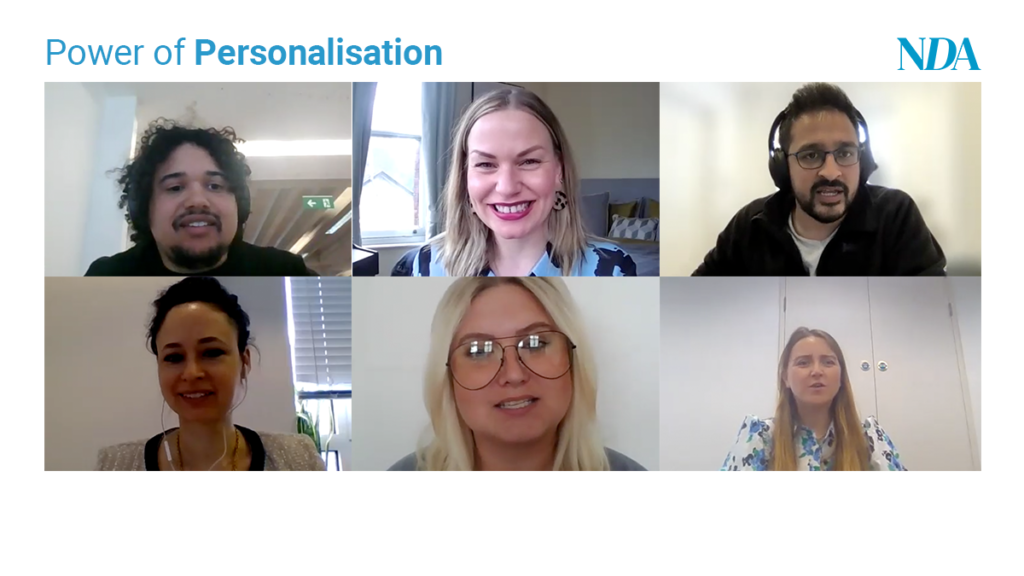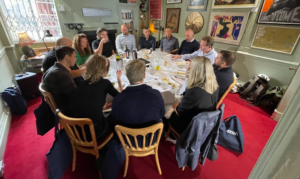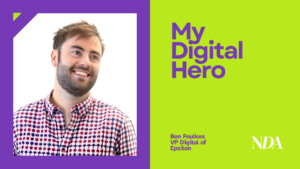New Digital Age teamed up with personalisation expert A Million Ads to host a roundtable on the ‘Power of Personalisation’ featuring the expert knowledge of Nicole Amodeo, Global Head of Addressable Creative at Mediacom; Lawrence Dodds, Client Director at Universal McCann (UM) London; Emma Jensen, Programmatic Director at Digitas UK; Lisa McAllister, Planning Business Director at m/Six; Sandeep Ahluwalia, Innovation Director at Essence; and A Million Ads’ Head of Commercial Partnerships, Silke Zetzsche.
A Million Ads recently released a report, interviewing 300 marketers and 2,000 consumers in the UK and US about the use and perception around personalisation and dynamic advertising.
“The topic of personalisation has become more important, particularly in the last year,” said A Million Ads’ Zetzsche. “So, we wanted to really look more closely at what consumers’ and brand marketers’ perceptions are around personalised advertising. When you look in the market, there’s not a lot of research around that. We thought we would take matters into our own hands and decided to conduct our own.”
The research found that 61% of UK consumers are willing to share data if it means they receive more personalised ads and offers – as long as it keeps content free and their data remains anonymous – and 77% feel annoyed when they see or hear the exact same ad over and over again.
The value exchange between brand and consumer
A big part of getting more consumers onboard with the idea of personalisation comes down to the industry helping the public to better understand how their data is used and building trust with the consumer – something that has suffered over the years of reliance on third-party cookies – according to m/Six’s McAllister.
“I work in media, I understand advertising, I understand that giving my data will probably end in a better result. But I think we all live in our little advertising bubble and forget that some of the general public feel that everyone is listening to them and spying on them,” she said.
“I don’t think the general public realises the value in that exchange. I’d rather get served a relevant ad than one from Gillette about shaving foam or something. It comes down to trust – and we’ve probably misused that over the last few years. When you go to many websites now you have to consent to that data being collected and, hopefully, that will build a better relationship. But there’s still a journey to do on that.”
For Essence’s Ahluwalia, it’s important that agencies don’t just solely focus on the value exchange for the consumer, but also seek ways to maximise value for all parties involved in the advertising process.
“I think there’s an interesting evolution that we’re going on in terms of the internet, and the infrastructure behind the internet, and what that means for the publisher ecosystem, let alone users as well,” he said.
“As responsible advertisers, we need to think about how we maximise the value for all parts of the ecosystem. How do we make this advertising valuable to consumers, to the places where we buy the media, and for the brands as well? As we think about briefs, it’s about trying to meld those three things and trying to frame the creative idea with the execution in a way that resonates with the user, first and foremost, but also has net benefits for the ecosystem and the brands that we’re advertising on behalf of as well.”
An education in personalisation
As mentioned by Ahluwalia, one of the key stakeholders in the whole process is the brand itself. And it is these brands that agencies are directly representing, so it’s equally important that they understand how personalisation works and what things like dynamic creative can offer.
“We’re asked by clients, with all the data and opportunities available for more relevant ads, ‘how do we find ways to deliver many versions of ads and be more efficient in our production?’ You can create thousands of versions of ads in one sitting of studio time using dynamic creative or by using a more templatised way of looking at production. That solves a lot of the challenges around the expense of digital production,” said Mediacom’s Amodeo.
“You have to do a little bit of work to shift perception around dynamic creative. There’s a lot of hand-holding and collaboration that you have to do with a lot of stakeholders. And, once clients get the bigger picture, they really do feel comfortable handing some of the creative control over to the automation side. If you plan it right and design it right, it’ll be great.”
Digitas’s Jensen agrees that there is an element of education involved with the client to make sure they’re comfortable from a creative point of view as well as with “the different datasets you’re using, GDPR, and all that fun stuff we love to deal with”.
At the same time, the Digitas team makes sure to put in place a strong relationship between their dynamic vendor and the client to aid this education.
“We also really work on that relationship with our dynamic vendor which, in this case, is A Million Ads,” said Jensen. “We collaborate very closely with the client and the A Million Ads team. The client is able to essentially extend their creative arm to be the team at A Million Ads, so there’s a lot of trust that is put into these guys.
“A lot of ownership sits with the agency to ensure that they choose the right dynamic partner and the one that works best for the client.”
Cookie death won’t crumble us
One of the other key considerations that exists is one of the things that we seem to talk about every day and one of the things that the industry is having to deal with from top to bottom: the death of the cookie.
The phrase ‘death of the cookie’ is something that all our roundtable participants agree has been worn out and overused. And, for UM’s Dodds, there’s really nothing to worry about when it comes to personalisation and dynamic creative.
“There are so many other data sources that it doesn’t concern me much when it comes to DCO (Dynamic Creative Optimisation),” he said. “Targeting data was only one part of it, contextual datasets are going to take over a lot of that burden when it comes to how we use the environment that the ad is going to be viewed in to inform creative, rather than scrap data from various datasets.
“Ultimately, that was always the best data, we’ve just been too reliant on behavioural datasets that we’ve got from other places. So, I’m not concerned about the death of the cookie. It gets us to think about all the other data that we had available to us before.”
Despite the potential stumbling blocks around cookies and education, the opportunity that exists around personalisation is clear to see, with the majority of consumers keen to avoid seeing or hearing repetitive and irrelevant advertising. And it’s up to brands, media agencies, creative agencies, and personalisation experts to come together and use what they have to their disposal to ensure they can deliver the best advertising experience for consumers – whether or not there are third-party cookies available to them.
*A Million Ads is a client of Bluestripe Communications, owned by Bluestripe Group, the owner of NDA.












